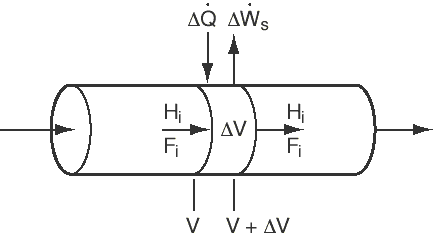Chapter 13: Unsteady State Nonisothermal Reactor Design
Professional Reference Shelf
R13.7 Unsteady Operation of Plug-Flow Reactors
|
We plan to reduce the energy balance into a more usable
form. To achieve this form for plug-flow
reactors, we begin by applying the balance to a small differential volume, |
|||
|
|
|||

Figure CD13.7 |
|||
Substituting for Ni and dividing |
|||

|
|||
Taking the limit as |
|||
|
|
|||
Rearranging, we have |
|||
|
|
(R13.7-1) |
||
Comparing Equations (R13.7-1) and (R13.7-2) |
|||
|
|
(R13.7-2) |
||
we note that the term in parentheses is just ri.
The rate of reaction of species i is related to the rate of disappearance
of species A through the stoichiometric coefficient, |
|||
|
|
|||
Then |
|||
|
|||
Finally, |
|||
|
|
|
||
where a is the heat exchange area per unit volume. Differentiating yields |
|||
|
|
|||
Recalling that |
|||
|
|
|||
we substitute these equations to obtain |
|||
|
|
|||
Neglecting shaft work and changes in pressure with respect to time, we obtain |
|||
|
Transient energy |
|
(R13.7-3) |
|
This equation must be coupled with the mole balances, |
|||
(R13.7-4) |
|||
|
Numerical solution |
|
||
and the rate law, |
|||
|
|
(R13.7-5) |
||
and solved numerically. A variety of numerical techniques
for solving equations of this type can be found in the book Applied Numerical
Methods.1 For steady-state operation in which no work is done by the system, Equation (R13.7-3) reduces to |
|||
|
|
(R13.7-6) |
||
Substitution for the molar flow rates Fi in terms of conversion gives Equation (R13.7-7). |
|||
|
Use this |
|
(R13.7-7) |
|
As stated previously, this equation is solved simultaneously with the mole balance. |





